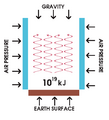Waste heat facts for kids
Waste heat is the by-product heat of machines and technical processes for which no useful application is found.
A fraction of input energy is always converted to heat by friction between machine parts and other processes such as liquid friction (see: viscosity).
Mechanical drives can be designed to run smoothly, with little loss of energy to heat. Machines for conversion of energy contained in fuels to mechanical work or electric energy produce large amounts of waste heat (see: Second law of thermodynamics).
This waste heat can be re-used if a cogeneration system is used. It is hard to use waste heat because it is difficult to transport the heat to another place, and it is difficult to store the heat for use at another time. In electrification of waste heat, organic matter can be used as a working medium to produce electricity on much lower temperatures compared to the water steam cycle.
Images for kids
-
Air conditioning units extract heat from a dwelling interior with coolant, and transfer it to the dwelling exterior as waste. They emit additional heat in their use of electricity to power the devices that pass heat to and from the coolant
-
Cooling towers evaporating water at Ratcliffe-on-Soar Power Station, United Kingdom.
See also
 In Spanish: Calor residual para niños
In Spanish: Calor residual para niños





